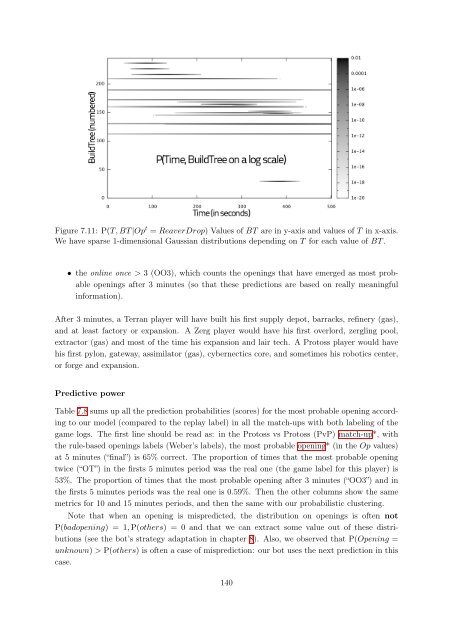Bayesian Programming and Learning for Multi-Player Video Games ...
Bayesian Programming and Learning for Multi-Player Video Games ...
Bayesian Programming and Learning for Multi-Player Video Games ...
You also want an ePaper? Increase the reach of your titles
YUMPU automatically turns print PDFs into web optimized ePapers that Google loves.
Figure 7.11: P(T, BT |Op t = ReaverDrop) Values of BT are in y-axis <strong>and</strong> values of T in x-axis.<br />
We have sparse 1-dimensional Gaussian distributions depending on T <strong>for</strong> each value of BT .<br />
• the online once > 3 (OO3), which counts the openings that have emerged as most probable<br />
openings after 3 minutes (so that these predictions are based on really meaningful<br />
in<strong>for</strong>mation).<br />
After 3 minutes, a Terran player will have built his first supply depot, barracks, refinery (gas),<br />
<strong>and</strong> at least factory or expansion. A Zerg player would have his first overlord, zergling pool,<br />
extractor (gas) <strong>and</strong> most of the time his expansion <strong>and</strong> lair tech. A Protoss player would have<br />
his first pylon, gateway, assimilator (gas), cybernectics core, <strong>and</strong> sometimes his robotics center,<br />
or <strong>for</strong>ge <strong>and</strong> expansion.<br />
Predictive power<br />
Table 7.8 sums up all the prediction probabilities (scores) <strong>for</strong> the most probable opening according<br />
to our model (compared to the replay label) in all the match-ups with both labeling of the<br />
game logs. The first line should be read as: in the Protoss vs Protoss (PvP) match-up*, with<br />
the rule-based openings labels (Weber’s labels), the most probable opening* (in the Op values)<br />
at 5 minutes (“final”) is 65% correct. The proportion of times that the most probable opening<br />
twice (“OT”) in the firsts 5 minutes period was the real one (the game label <strong>for</strong> this player) is<br />
53%. The proportion of times that the most probable opening after 3 minutes (“OO3”) <strong>and</strong> in<br />
the firsts 5 minutes periods was the real one is 0.59%. Then the other columns show the same<br />
metrics <strong>for</strong> 10 <strong>and</strong> 15 minutes periods, <strong>and</strong> then the same with our probabilistic clustering.<br />
Note that when an opening is mispredicted, the distribution on openings is often not<br />
P(badopening) = 1, P(others) = 0 <strong>and</strong> that we can extract some value out of these distributions<br />
(see the bot’s strategy adaptation in chapter 8). Also, we observed that P(Opening =<br />
unknown) > P(others) is often a case of misprediction: our bot uses the next prediction in this<br />
case.<br />
140


